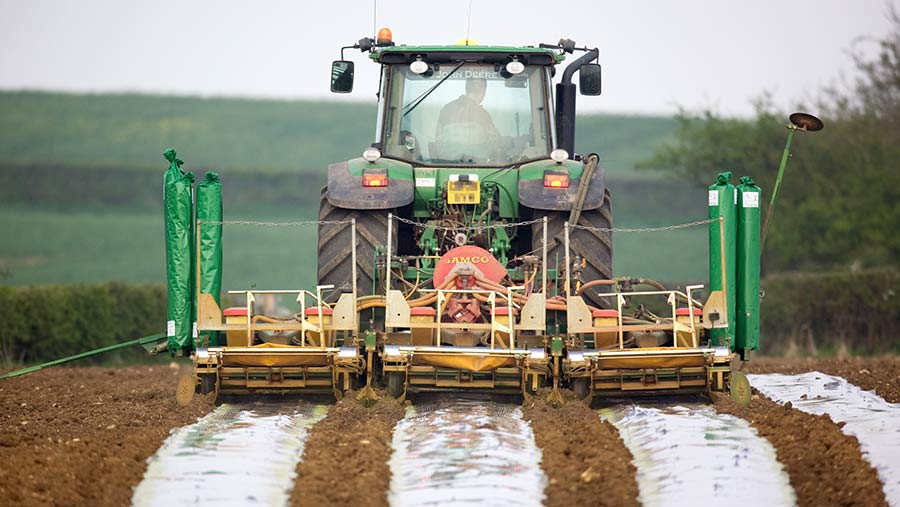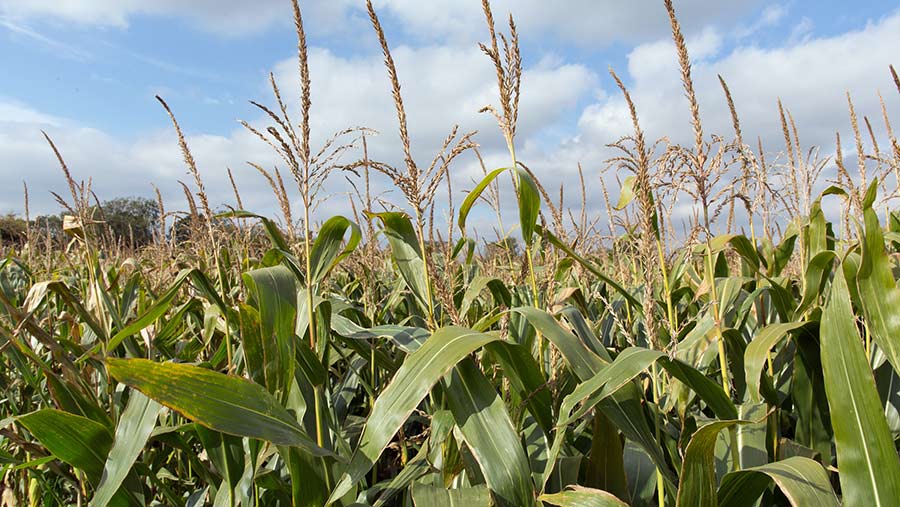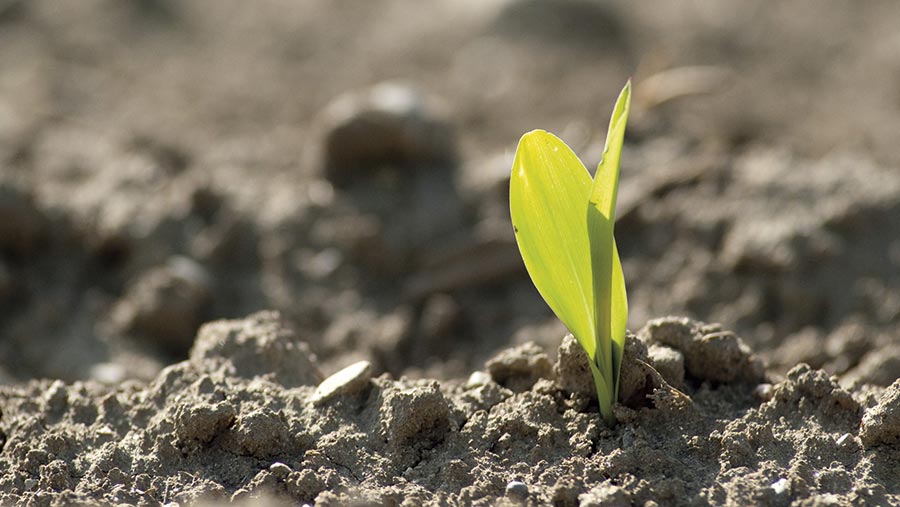How to give maize the best possible start
Farmers who have been left feeling deflated by their maize yield this season while others around them did well may well reflect that poor establishment was probably the reason. So how can they do better in this area for 2018?
Growers should decide whether they are chasing crop yield or quality before a maize seed is planted so they can fine-tune agronomy decisions throughout the season.
A high starch content crop for feeding, which tends to be lower yielding, needs a different approach to a low starch, higher yielding crop, especially when it comes to the target plant population.
That’s according to independent agronomist Simon Draper of the Maize Growers Association, who points out that it will have a bearing on variety selection and seed rates.
See also: Farmers’ verdicts on 2017 wheat disease strategies
He says a lower starch, higher yielding crop will require more plants per ha than a quality crop with a high starch content for feeding.
“Starchy crops tend to be grown with early varieties, while bulky crops come from later maturing types,” he says.
Similarly, there’s a distinction to be made concerning crops being grown for anaerobic digestion over whether throughput or yield are more important.
“The general rule is to go for bulk, in the form of green material. But that won’t be the case for everyone,” says Mr Draper.
Establishment
Maize is very susceptible to compaction and will give up very quickly if it is unable to get its roots in to the ground easily.
“It’s a weak rooter,” he warns. “Maize needs to go into a good seedbed which allows optimum seed to soil contact and early root development. It doesn’t like to sit in wet, cold soils.”
The ideal situation is to subsoil in the autumn, when it’s dry, to avoid any soil structure problems and then use the most appropriate cultivation technique in the spring.
“There’s a balance to be achieved between creating an even seedbed depth without leaving any compaction.”

© Tim Scrivener
Drilling date is dependent on soil temperature, so he advises using a soil thermometer in April at 9am every day and waiting until it hits 9-10°C for a week before you start.
“Again, there’s a balance between getting the crop in as early as possible to maximise starch content and waiting for perfect ground conditions.”
Most maize seedbed preparation and drilling is undertaken by contractors. The crop is usually precision drilled in rows 76cm apart, with the seeds evenly spaced within the row and placed at a consistent depth between 5-9cm.
This encourages them to emerge at the same time, minimising competition between plants.
Drilling speed has a role, with slower speeds being preferred, so that depth control is maintained.
Seed Rate
Seed rates will vary with maize type – where growers are going for bulk, they need to get 90-100,000 plants/ha established, but for high starch content, they should aim for 70,000-80,000 plants/ha established.
Although base fertiliser applications will have taken place before drilling, there’s a good case for starter fertiliser down the spout at drilling, placed no more than half an inch below or to the side of the seed to kick-start feeble roots.
This will give the crop a boost and encourage vigorous early growth, although it is site and season dependent.
“In a warm season and with a May drilling date, you won’t necessarily see any benefit. But if it’s cold and wet, there will be one.”
He also warns that growers should keep an eye on the contractor as the drilling operation gets under way because the crop is such a feeble rooter and poor competitor.
“If there’s any delayed emergence, the crop will compete with itself and the big plants will be victorious. So you need very even emergence, which comes from the correct depth of planting and consistent spacing between plants.”

© Tim Scrivener
Weed Control
As the maize crop is emerging, it can’t cope with competition – so weed control during the first six weeks after sowing is crucial.
“Once it’s up, it’s a good competitor,” reports Mr Draper. “So by the six leaf stage, everything changes.”
The best practice in most years is to use two sprays – a pre-emergence treatment followed by an early post-emergence spray, although one spray will suffice in some years.
Pre-emergence product choice should be influenced by the amount of soil moisture present, he advises.
“They don’t work as well in dry seedbeds. In these situations, they will slow down weed emergence enough to allow you to make good post-emergence strike.”
Any delay in getting the post-emergence application on can be detrimental to yields, which is why growers should always plan for a two-spray programme.
“There isn’t a huge choice of herbicide products for maize,” points out Mr Draper. “Application timing is more important than product choice – you’re after small weeds before they can have any lasting effect on the crop.”
Where blackgrass control is needed, there can be a case for an extra spray later on but he advises checking with an agronomist to confirm the product will not damage the crop.
A herbicide programme costs will vary from around £45/ha up to £110/ha, depending on the approach taken.
“Take time to identify problem weeds, as there can be good savings from using the most cost-effective treatment,” he advises.
Crop Nutrition
Most maize crops receive a good nutrient hit from slurry applications made in the winter, with some fields receiving large quantities of farmyard manure (FYM).
Any remaining nitrogen requirement is then very dependent on what you are trying to achieve – bulk or starch – with most crops requiring around 150kg/ha of nitrogen, although there will be significant variation depending on field history.
The Maize Growers Association offers members the use of a nitrogen predictor which will help give an accurate assessment of the field’s requirements.
Nutrient applications should be timed to coincide with crop growth to maximise uptake and avoid nutrient overload, as any surplus nutrients can be lost via run-off or leaching, he emphasises.
As well as nitrogen, maize has a requirement for about 180kg/ha of potash, much of which can be supplied by FYM in the winter.
Any additional potash should be applied at drilling, but the nitrogen should be split so that half is applied at the 2-4 leaf stage of the crop.
“It’s important to avoid leaf scorch, which can happen when the nitrogen prills get trapped between the leaf and the stalk, which is why the two-leaf stage works well.”
Lime is also important, he adds. “It’s worth checking your soil pH. Maize has poor tolerance of acidic soils.”

© Dirk V Mallinckrodt/imageBROKER/REX/Shutterstock
Fresh pest warning for southern growers
A new and worrying pest of the UK maize crop is stem borer, which is already a serious issue on the continent, and has been found in the south of the UK for the last two years.
“Crops being grown on the south coast have been infected, as the moths have blown over from France,” he reports.
Where they lay eggs in crops, the caterpillars hatch and bore into the base of the maize plants, working their way up the plant. This causes the ear to drop to the ground, with crops lodging and yield being lost.
“Once they’re established, you can’t grow maize on those sites again. So we need to remain vigilant and do our best to eradicate this pest and prevent it becoming widespread.”

